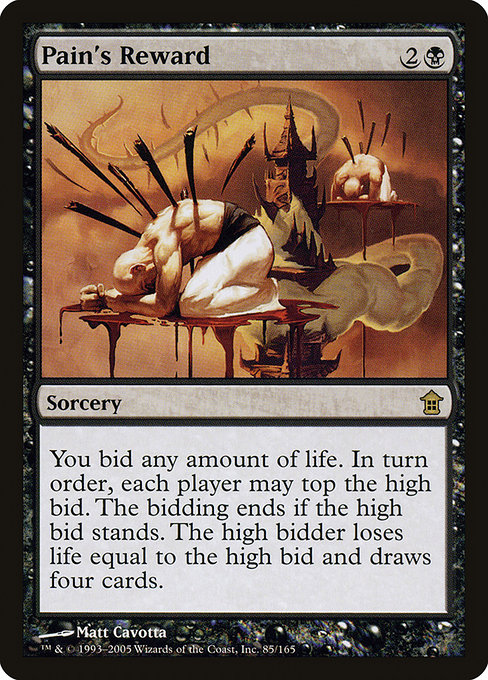
Image courtesy of Scryfall.com
Exploring Cross-Format Design with Pain's Reward
Magic: The Gathering thrives on the tension between elegant mechanical constraints and the wild, unpredictable chaos of human play. Pain's Reward, a black sorcery from Saviors of Kamigawa, serves as a prime example of how a card’s design philosophy travels gracefully (and sometimes awkwardly) across formats 🧙♂️🔥. With a modest mana cost of {2}{B}, it invites a bidding duel that is as much about psychology as it is about resource management. The very idea of life as currency—start the bid, top the high bid, and risk life loss for four fresh cards—reads like a cross-format handshake between paper table talk and digital automation. The result is a design that must feel equally fair on a casual kitchen-table duel and on a high-stakes retrospective analysis of Legacy and Vintage play 💎⚔️.
Card snapshot: what Pain’s Reward brings to the table
- Name: Pain's Reward
- Type: Sorcery
- Mana cost: {2}{B}
- Colors: Black
- Rarity: Rare
- Set: Saviors of Kamigawa (SOK)
- Text: Each player may bid life. You start the bidding with a bid of any number. In turn order, each player may top the high bid. The bidding ends if the high bid stands. The high bidder loses life equal to the high bid and draws four cards.
The elegance here is in the negotiation of risk. Unlike most spells, Pain’s Reward turns life into a resource that is both public and strategic, forcing dentists of decision-making at every counter-offer. In a two-player game, the first bid often sets the tone for a tense micro-competition; in multiplayer formats like Commander, the table dynamic can swing from a friendly auction to a dramatic life-toll as soon as one player edges the high bid and the cards start flying. This is exactly the sort of cross-format constraint that designers must anticipate: a mechanic that plays smoothly in a contained duel—yet scales to a multi-way table with different life totals and political incentives 🧩🎲.
Cross-format constraints in practice: what designers wrestle with
When you translate Pain’s Reward from a single-format mindset into a cross-format reality, a few constraints come into focus:
- Life as a resource: Across formats, life totals and the cadence of bidding differ. In Legacy and Vintage, players are comfortable with aggressive life-loss swings; in Commander, there’s a premium on table politics and long-range planning. Ensuring the spell remains fair without becoming oppressive requires careful consideration of life total pacing and potential exits from the bidding ladder 🧠💡.
- Interaction with draw engines: The draw four cards payoff is a meaningful incentive, but it must be balanced against the cost. In formats with strong card advantage pipelines, the spell can swing too hard; in formats with slower draw decks, it may underperform. Designers balance by adjusting format legality and by calibrating the bidding dynamic so the effect remains a strategic choice rather than an auto-win button ⚖️.
- Table dynamics in multiplayer: In Commander,Pain’s Reward tests table etiquette and risk tolerance. It can become a players-as-mechanics game where diplomacy, betrayal, and sudden life loss influence perceived fairness. The cross-format challenge is to preserve the card’s flavor without enabling table-breaking loops or unwinnable states for casual tables 🧭🎎.
- Accessibility for digital versus physical play: In MTGO or Arena-based products, bidding mechanics can be streamlined, animated, and audibly signposted to avoid confusion. In physical games, players rely on social cues and explicit verbal bids. The cross-format constraint: a spell that’s easy to teach in person but benefits from careful UX in digital implementations 🔍🎮.
Beyond the numbers, Pain's Reward nudges designers to think about flavor, pacing, and table psychology. The artwork—crafted by Matt Cavotta—captures a moment of tense risk that mirrors the spell’s mechanical heartbeat. When the bidding ends and the high bidder pays life to draw four cards, the table is left with stories to tell: clutch draws, near-misses, and the tiny emotional teeter-totter that makes MTG so memorable 🎨🧙♂️.
Practical guidance for players and builders
If you’re slotting Pain's Reward into a deck—whether in Modern-legal black builds or in Legacy/Commander environments—consider how your group navigates risk and negotiation. In two-player formats, this spell rewards players who excel at risk assessment and psychological play; in multiplayer formats, it benefits decks that can leverage the card draw or shift life totals around the table in a controlled way. A smart approach often pairs Pain’s Reward with protective measures or ways to balance life loss with gains elsewhere in the deck. Think life-redistribution synergies, life gain subthemes, and cards that encourage thoughtful table talk rather than aggressive targeting 🔮🧪.
From a collectible lens, Pain's Reward sits in the rare echelon, with modern and legacy demand reflecting its quirky, memorable effect. The card’s price point underscores its status as a conversation piece for players who enjoy budget-conscious but impactful black spells, while foils fetch heftier values for dedicated collectors. The design remains a reminder that a single spell can weave into formats with very different expectations—the mark of a true cross-format design constraint masterwork 🔎💎.
Non-slip Gaming Mouse Pad – Polyester Surface, Anti-FRAY (9.5x8)More from our network
- https://blog.digital-vault.xyz/blog/post/flicker-signed-copies-mtg-auction-trends-and-values/
- https://transparent-paper.shop/blog/post/mastering-efficient-api-integration-for-scalable-apps/
- https://blog.digital-vault.xyz/blog/post/ai-generated-paper-patterns-reshape-sewing-for-makers/
- https://blog.digital-vault.xyz/blog/post/mastering-google-analytics-to-track-product-metrics/
- https://blog.zero-static.xyz/blog/post/sideboard-spotlight-assault-intercessor-in-meta-matchups/